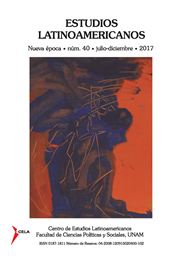On Localized Agrifood Systems. From the Industrial District to territorial development
Main Article Content
Abstract
Downloads
Article Details
Citas en Dimensions Service
References
Bibliohemerografía
ALTENBURG, T., y J. MEYER-STAMER (1999), “How to promote clusters: Policy experiences from Latin America”, en World Development, vol. 27, núm. 9.
BÉRARD, L., M. CEGARRA, M. DJAMA, S. LOUAFI, P. MARCHENAY, B. ROUSELL & François VERDEAUX (editores) (2005), Biodiversité et savoirs naturalistes locaux en France, France, Editions Quae.
BOISIER, S. (2010), “Descodificando el desarrollo del siglo XXI: subjetividad, complejidad, sinapsis, sinergia, recursividad, liderazgo y anclaje territorial”, en Semestre Económico, vol. 13, núm. 27.
BOUCHER, F., D. REQUIER-DESJARDINS y V. BRUN (2010), SYAL: un nouvel outil pour le developpement de territoires marginaux. Les leçons de l’alliance des agro-industries rurales de la selva lacandona, Chiapas, Montpellier, Francia, Innovation C.U.M.R. Dirección URL: <http://www.isda2010.net>.
BOWEN, S. (2015), Divided spirits: Tequila, mezcal, and the politics of production, Oakland, California, University of California Press.
BOWEN, S., y T. MUTERSBAUGH (2014), “Local or localized? Exploring the contributions of franco-mediterranean agrifood theory to alternative food research”, en Agriculture and Human Values, vol. 31, núm. 2.
BRAUDEL, F. (1976), El Mediterráneo y el mundo mediterráneo en la época de Felipe II [La Méditerranée et le monde méditerranéen à l’époque de Philippe II, 1949, 1966, Paris, Librarie Armand Colin], México, Fondo de Cultura Económica, 2ª. edición, traducción de Mario Monteforte Toledo, Wenceslao Roces y V. Simón.
CAMPOS ORTIZ, G. T. (2017), Estrategias de soberanía alimentaria en América Latina: propuestas en México y Cuba para su aplicación, México, Posgrado en Estudios Latinoamericanos, UNAM, tesis de doctorado en Estudios Latinoamericanos.
COURLET, C., (2002), “Les systèmes productifs localisés. Un bilan de la literature”, en Etudes et Recherches sur les Systèmes agraires et le Développement, núm. 33.
COURLET, C. (2016), “El momento territorial”, en G. TORRES SALCIDO (editor), Territorios en movimiento. Sistemas agroalimentarios localizados, innovación y gobernanza, México, Bonilla Artigas/Centro de Investigaciones sobre América Latina y el Caribe, UNAM.
CHAMPREDONDE BORDENAVE, M. (2008), “Localización, deslocalización, ¿relocalización? de la calidad de las carnes vacunas pampeanas argentinas. Impacto territorial”, en I. VELARDE, A. MAGGIO y G. OTERO (editores), Sistemas agroalimentarios localizados en Argentina, Argentina, Instituto Nacional de Tecnología Agropecuaria (INTA).
DOMÍNGUEZ ARISTA, D. R. (2016), “Los avatares de la producción artesanal de mezcal: la denominación de origen, la exclusión y las alternativas”, en M. RENARD HUBERT (editor), Mercados y desarrollo local sustentable, México, Red Sial México/CONACYT/Colofón.
FAO (2007), Agricultura y desarrollo rural sostenibles (ADRS). Sumario de política, Roma, FAO.
FRAYSSIGNES, J. (2001), “L’ancrage territorial d’une filière fromagère d’AOC. L’exemple du système roquefort”, en Économie Rurale, vol. 264, núm. 1.
HAESBAERT, R. (2011), El mito de la desterritorialización. Del ‘fin de los territorios´ a la multiterritorialidad, México, Siglo XXI.
LINCK, T., E. BARRAGÁN LÓPEZ y F. CASABIANCA (2006), “De la propiedad intelectual a la calificación de los territorios: lo que cuentan los quesos tradicionales”, en Agroalimentaria, núm. 22, enero-junio.
MARSHALL, A. (1919), Industry and trade: A study of industrial technique and business organization, and of their influences on the conditions of various classes and nations, Londres, Macmillan and Co.
MARSHALL, A., (1920 [1890]), Principles of economics: An introductory volume, Londres, Macmillan and Co.
MONACHON, D. (2016), “Redes alimentarias alternativas: institucionalización de la agroecología y procesos de garantía”, en M. RENARD HUBERT (editor), Mercados y desarrollo local sustentable, México, Red Sial México/CONACYT/Colofón.
MUCHNIK, J., J. SANZ CAÑADA y G. TORRES SALCIDO (2008), “Systèmes agroalimentaires localisés: état des recherches et perspectives”, en Cahiers Agricultures, France, vol. 17, núm. 6, noviembre-diciembre.
PECQUEUR, B. (2001), “Qualité et développement territorial: L’hypothèse du panier de biens et de services territorialisés”, en Économie Rurale, vol. 261, núm. 1.
PECQUEUR, B., (2004), “Vers une géographie économique et culturelle autour de la notion de territoire”, en Géographie et Culture, núm. 49.
POLANYI, K. (2006), La gran transformación. Los orígenes políticos y económicos de nuestro tiempo, México, Fondo de Cultura Económica, 2a. edición, traducción de E. L. Suárez y R. Rubio.
PENSADO, Mario (2014), “Los sistemas alimentarios sostenibles y los Sial con criterios ambientales”, en G. TORRES SALCIDO (coordinador), Los sistemas agroalimentarios y el consumo local, México, Asociación Mexicana de Estudios Rurales (AMER), vol. II., E. GUZMÁN GÓMEZ, G. ESPINOZA DAMIÁN y R. QUINTANA (editores), Colección “Campesinos y procesos rurales. Diversidad, disputas y alternativas”.
PORTER, M., (1998), “Clusters and the new economic of competition”, en Harvard Bussiness Review, Boston, Mass., Harvard Bussiness School, vol. 76, núm. 6.
PORTO GONÇALVES, C. W. (2001), Geo-grafías. Movimientos sociales, nuevas territorialidades y sustentabilidad, México, Siglo XXI.
PYKE, F., G. BECATTINI y W. SENGENBERGER (1990), Industrial districts and inter-firm cooperation in Italy, Génova, International Institute for Labour Studies.
PYKE, F. y W. SENGENBERGER (1992), Industrial districts and local economic regeneration, Génova, International Institute for Labour Studies.
RAMOS CHÁVEZ, A., G. TORRES SALCIDO y Á. URRETA FERNÁNDEZ (2010), “Nopal y comunidad en Tlalnepantla, Morelos”, en La jornada del campo. Suplemento informativo de La Jornada, III, México, 13 de febrero.
SCHMITZ, H., (1995), “Small shoemakers and fordist giants: Tale of a supercluster”, en World Development, vol. 23, núm. 1.
SCHUMPETER, J. A. (1982), Capitalismo, socialismo y democracia, Buenos Aires, Editorial Claridad.
SEN, A. (1999), Commodities and capabilities, Nueva Delhi, Oxford University Press.
TORRES SALCIDO, G., y R. MEINERS (2010), “Producción de Huitlacoche en Tlaxcala”, en La jornada del campo. Suplemento informativo de La Jornada, III, México, 13 de febrero.
TORRES SALCIDO, G. (coordinador) (2014), Los sistemas agroalimentarios y el consumo local, México, Asociación Mexicana de Estudios Rurales (AMER), vol. II., E. GUZMÁN GÓMEZ, G. ESPINOZA DAMIÁN y R. QUINTANA (editores), Colección “Campesinos y procesos rurales. Diversidad, disputas y alternativas”.
VAN DIJK, M. P. y R. RABELLOTTI (editores) (1997), Enterprise clusters and networks in developing countries, Londres, Routledge.

Este obra está bajo una licencia de Creative Commons Reconocimiento-NoComercial-SinObraDerivada 4.0 Internacional.

